Race car vehicle dynamics is a fundamental study of forces and systems in racing, explored in-depth in Milliken’s seminal book, essential for engineers and enthusiasts, serving as the definitive reference.
1.1. Understanding the Fundamentals of Vehicle Dynamics
Vehicle dynamics encompasses the study of how forces and moments interact within a race car, influencing its motion, stability, and performance. It involves understanding key components like tires, suspension, and aerodynamics, which collectively shape the car’s behavior on the track. Fundamental concepts such as weight transfer, traction, and balance are critical to optimizing speed and control. Engineers use mathematical models and simulations to analyze these interactions, ensuring the car operates efficiently under varying conditions. Mastery of these principles is essential for designing race cars that deliver peak performance while maintaining stability and responsiveness.
1.2. The Role of Engineers in Race Car Design
Engineers play a pivotal role in race car design, leveraging their expertise in vehicle dynamics to optimize performance, stability, and control. They analyze forces, moments, and system interactions, utilizing tools like mathematical models and simulations to enhance design. By applying principles from Milliken’s Race Car Vehicle Dynamics, engineers refine components such as suspension, aerodynamics, and powertrain for peak efficiency. Their work involves iterative testing, data analysis, and collaboration to ensure the car meets performance goals while maintaining safety and reliability, making them indispensable in achieving competitive advantages in racing.
1.3. The Impact of Vehicle Dynamics on Racing Performance
Vehicle dynamics significantly influences racing performance by optimizing speed, stability, and control. Properly engineered dynamics enhances tire grip, reduces drag, and maximizes downforce, directly improving lap times. Advanced systems like aerodynamics and suspension tuning, as detailed in Race Car Vehicle Dynamics, ensure vehicles maintain optimal performance under various conditions. Engineers analyze forces and moments to refine designs, ensuring vehicles handle efficiently and maintain stability during high-speed maneuvers. This optimization is crucial for achieving competitive advantages, making vehicle dynamics a cornerstone of successful race car engineering and performance.

The Concept of Race Car Vehicle Dynamics
Race car vehicle dynamics involves studying interactions among systems like powertrain, suspension, and aerodynamics, focusing on forces and moments affecting vehicle motion, stability, and performance optimization.
2.1. Definition and Scope of Vehicle Dynamics in Racing
Vehicle dynamics in racing refers to the study of forces and moments acting on a race car, influencing its motion, stability, and performance. This field encompasses the interaction of key systems such as powertrain, suspension, tires, and aerodynamics. It aims to optimize how these components work together to enhance speed, handling, and control. By understanding vehicle dynamics, engineers can design cars that achieve better lap times, improved stability, and increased driver control, making it a cornerstone of modern race car engineering and performance optimization.
2.2. Key Systems Involved: Powertrain, Suspension, Aerodynamics
The powertrain, suspension, and aerodynamics are critical systems in race car dynamics. The powertrain optimizes power delivery for acceleration and speed. The suspension ensures stability and control by managing tire contact and vehicle balance. Aerodynamics enhances performance by reducing drag and generating downforce, improving cornering speeds. These systems interact to maximize efficiency, stability, and speed, making them essential for competitive racing.
2.3. The Interaction of Forces and Moments in Race Cars
The interaction of forces and moments in race cars is crucial for understanding their dynamic behavior. Tire forces, aerodynamic downforce, and inertial forces collectively influence the car’s motion. Moments, resulting from force distribution, affect yaw, pitch, and roll. Engineers analyze these interactions using methods like the moment method and pair analysis to optimize stability and responsiveness. Proper force distribution enhances cornering grip, braking efficiency, and acceleration, ensuring the car performs optimally under various racing conditions. This analysis is vital for designing competitive race cars, as it directly impacts lap times and handling characteristics.
Tire Dynamics in Race Cars
Tire dynamics are critical in race cars, influencing grip, slip, and wear; Understanding these factors ensures optimal performance, stability, and handling on the track.
3.1. Tire Behavior and Its Impact on Vehicle Performance
Tire behavior is pivotal in race car performance, with factors like slip angles, camber, and traction directly affecting handling and speed. Proper tire management enhances stability and responsiveness, ensuring optimal cornering and braking capabilities. The relationship between tire deformation and load transfer is crucial, as it influences grip levels and overall vehicle balance. Understanding these dynamics allows engineers to fine-tune setups for maximum efficiency, making tires a cornerstone of race car performance optimization and a key area of focus in vehicle dynamics analysis.
3.2. Understanding Tire Characteristics: Grip, Slip, and Wear
Tire grip is essential for race car performance, determined by frictional forces between the tire and track. Slip refers to the angular difference between the tire’s direction and its actual path, affecting handling. Managing slip angles is critical for optimal cornering. Tire wear results from friction and heat, balancing durability and performance. Understanding these characteristics helps engineers tune setups, enhancing stability and speed. Proper tire management ensures consistent performance over races, making it a vital aspect of race car dynamics and a key focus in Milliken’s analysis.
3.3. Tire Data Analysis and Its Application in Racing
Tire data analysis is crucial for optimizing race car performance. By collecting and interpreting data on tire temperature, pressure, and slip angles, engineers can identify patterns and trends. Advanced tools, such as tire data normalization, help quantify grip levels and predict performance under varying conditions. This data is used to fine-tune setups, improving lap times and handling. Milliken’s work emphasizes the importance of tire data in understanding behavior and enhancing vehicle dynamics. Predictive analytics also aids in anticipating tire wear, enabling strategic decisions during races. Tire data analysis is a cornerstone of modern race car engineering and competition strategy.
Aerodynamics in Race Car Design
Aerodynamics plays a crucial role in race car performance, balancing downforce and drag to enhance speed and stability. Advanced testing optimizes airflow for competitive edge.
4.1. The Principles of Aerodynamics in Racing
The principles of aerodynamics in racing focus on manipulating airflow to maximize performance. Downforce generation is critical for cornering stability, while drag reduction enhances straight-line speed. Airflow around the car creates pressure differences, with lower pressure above the car and higher below, generating downforce. Teams use advanced tools like wind tunnels and computational fluid dynamics (CFD) to optimize designs. Understanding these principles allows engineers to balance aerodynamic efficiency with mechanical grip, ensuring optimal performance on the track. These concepts are extensively covered in Milliken’s Race Car Vehicle Dynamics, a key resource for aerodynamic analysis.
4.2. Downforce, Drag, and Their Effects on Speed
In racing, downforce and drag are critical aerodynamic factors. Downforce enhances cornering stability by pushing the car onto the track, while drag resists forward motion, impacting straight-line speed. The balance between these forces is crucial for optimal performance. Engineers use aerodynamic devices like wings and diffusers to maximize downforce while minimizing drag. Advanced tools such as wind tunnels and computational fluid dynamics (CFD) aid in refining designs. These principles are detailed in Milliken’s Race Car Vehicle Dynamics, emphasizing their role in achieving competitive advantage. Balancing these forces is key to maximizing speed and handling in race cars.
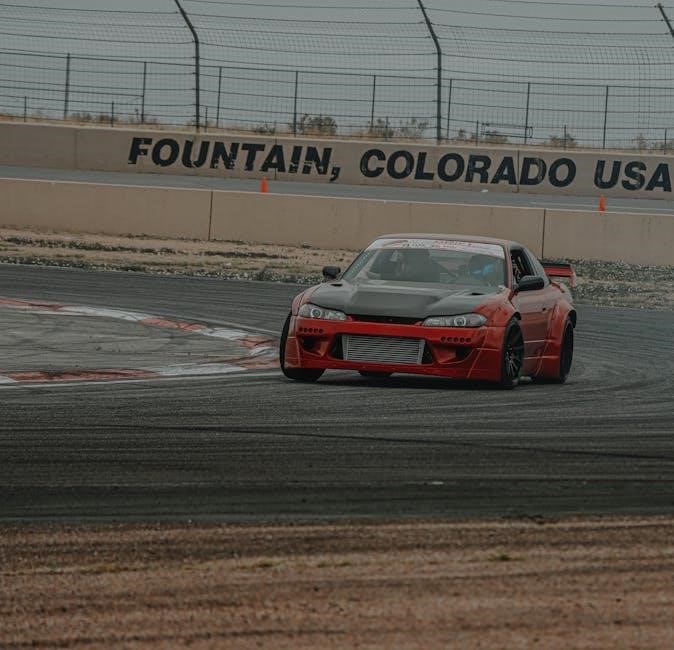
4.3. Aerodynamic Testing and Optimization
Aerodynamic testing is vital for optimizing race car performance. Methods like wind tunnel testing and computational fluid dynamics (CFD) provide detailed insights into airflow and pressure distributions. Teams analyze data to enhance downforce and reduce drag. On-track testing validates simulations, ensuring real-world applicability. Iterative design refinement is crucial for achieving aerodynamic efficiency. These techniques are extensively covered in Milliken’s Race Car Vehicle Dynamics, emphasizing their role in competitive racing. Continuous testing and optimization ensure cars are aerodynamically superior, contributing significantly to overall performance and success on the track.
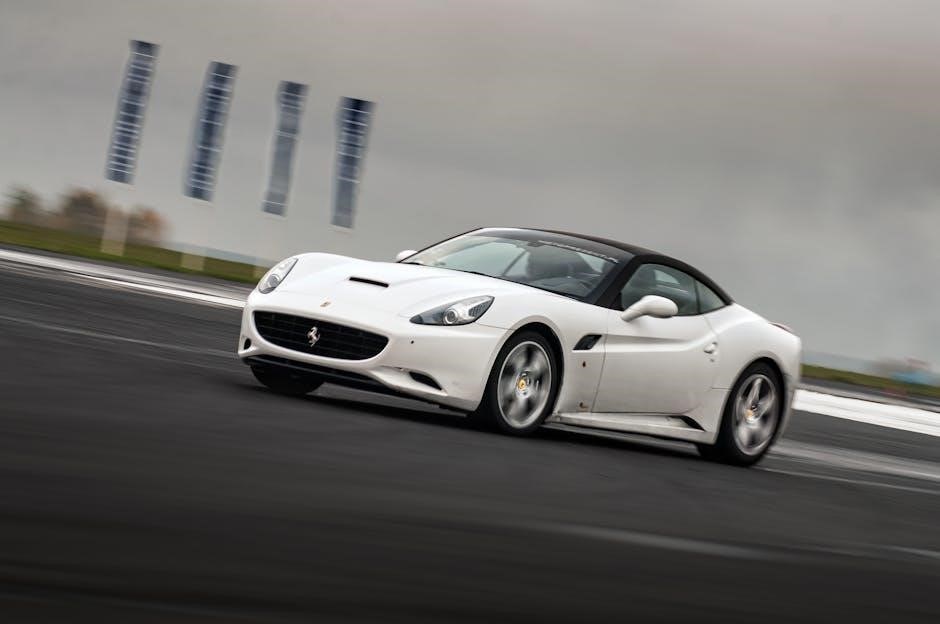
Suspension and Chassis Dynamics
Suspension and chassis dynamics are critical for handling and stability, explored in-depth in Milliken’s Race Car Vehicle Dynamics, enhancing race car performance and driver control.
5.1. The Role of Suspension in Vehicle Stability
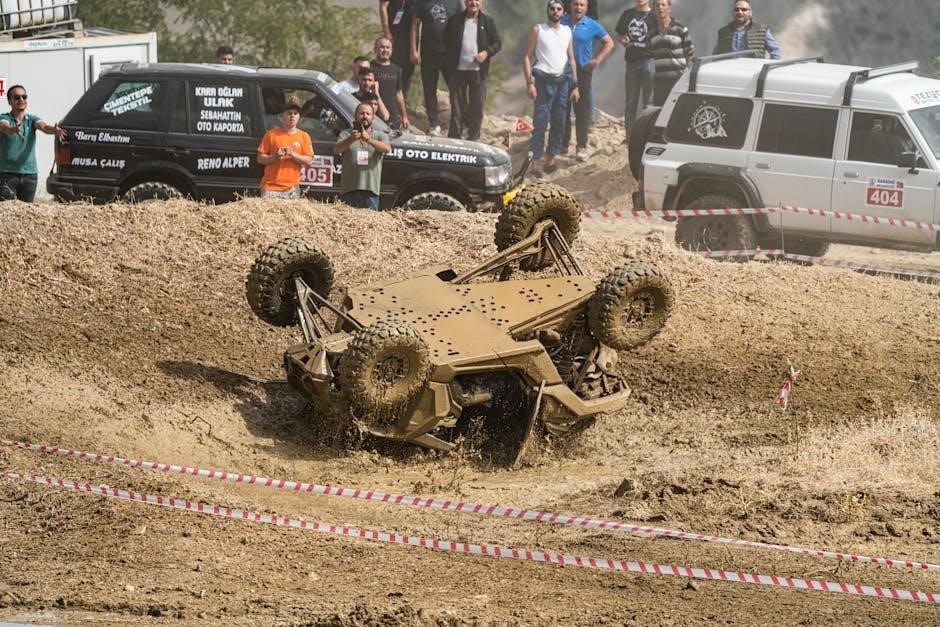
The suspension system plays a vital role in maintaining vehicle stability by managing the distribution of forces and moments acting on the race car. It ensures proper tire contact with the track, minimizing uneven wear and optimizing grip. Through precise kinematics and dynamic adjustments, the suspension enhances cornering performance and reduces pitch and roll during acceleration or braking. Advanced designs, such as multi-link systems, improve handling and responsiveness, while maintaining ride comfort. As detailed in Race Car Vehicle Dynamics, the suspension’s ability to balance stability and flexibility is crucial for competitive racing performance, requiring meticulous engineering and testing.
5.2. Chassis Design and Its Influence on Handling
Chassis design is integral to race car handling, providing the structural foundation for optimal performance. A stiff yet lightweight chassis ensures precise responsiveness to driver input and maintains stability under varying loads. As outlined in Race Car Vehicle Dynamics, advanced materials and construction techniques minimize flex and enhance torsional rigidity, critical for consistent handling. The chassis also serves as the mounting point for suspension and aerodynamic components, making its design a pivotal factor in achieving balance and maximizing grip. Effective chassis engineering directly translates to improved lap times and overall racing success.
5.3. Kinematics and Dynamics of Suspension Systems

Suspension systems in race cars are critical for maintaining tire contact and stability. Kinematics focuses on the motion of suspension components, such as control arms and linkages, while dynamics examines the forces acting on them. Together, they influence how the car responds to inputs like braking, acceleration, and cornering. As detailed in Race Car Vehicle Dynamics, proper suspension design ensures optimal weight transfer and roll resistance, enhancing grip and handling. Engineers use advanced tools to model these interactions, ensuring the suspension system maximizes performance while maintaining driver control and stability under extreme racing conditions.
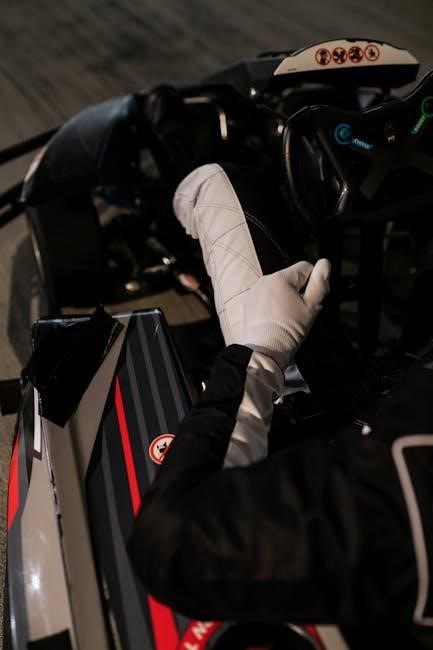
Stability and Control in Race Cars
Stability and control in race cars involve managing understeer, oversteer, and yawing. Advanced systems optimize tire forces and aerodynamic balance, enhancing driver control and performance, as detailed in the PDF.
6.1. Understanding Understeer and Oversteer
Understeer occurs when a car’s front axle exceeds its grip limit, causing the vehicle to turn less than intended, while oversteer is when the rear axle loses grip, making the car rotate more than expected. Both phenomena significantly impact handling and stability, requiring precise driver input and chassis tuning to correct. These conditions are critical in race car dynamics, as they directly affect lap times and safety.
The PDF provides detailed analysis of understeer and oversteer, including their causes, effects, and mitigation strategies. Engineers use advanced tools to predict and optimize these behaviors, ensuring better performance and control on the track.
6.2. Stability in Yawing and Its Implications
Yawing refers to a car’s rotation around its vertical axis, influenced by weight distribution and aerodynamic forces. Stability in yawing ensures predictable handling during cornering and evasive maneuvers. A stable yaw response enhances driver confidence and reduces the risk of spins or loss of control. Engineers analyze yaw stability through simulations and testing, optimizing suspension geometry and aerodynamic balance to achieve consistent performance.
The PDF elaborates on yawing dynamics, detailing how factors like roll centers and tire characteristics affect stability, and providing insights into advanced control systems for maintaining optimal yaw behavior.
6.3. Advanced Control Systems for Race Cars
Modern race cars utilize advanced control systems to optimize performance, stability, and efficiency. These systems integrate real-time data from sensors to adjust power distribution, braking, and suspension settings. Electronic Stability Control (ESC) and Traction Control (TC) are critical components, ensuring maximum grip and minimizing wheel spin. Additionally, AI-driven systems predict optimal vehicle behavior, adapting to dynamic conditions. The PDF highlights how these technologies enhance driver control, reduce lap times, and improve safety by maintaining stability under extreme conditions. These innovations are pivotal in achieving competitive advantages in motorsport engineering.
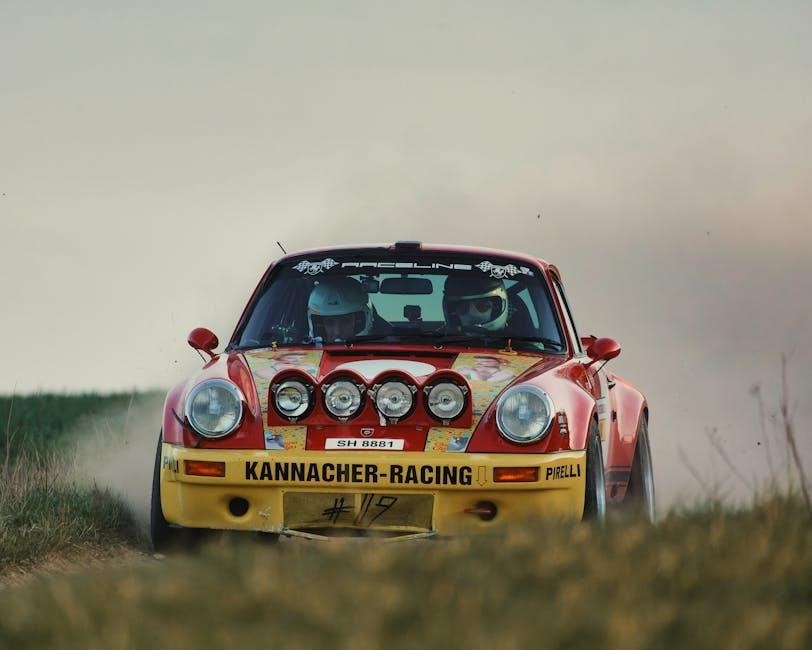
The Role of Mathematics in Vehicle Dynamics
Mathematics is crucial in analyzing race car dynamics, enabling precise modeling of forces, moments, and motion. It aids in simulations, lap time analysis, and optimizing vehicle performance through data-driven insights.
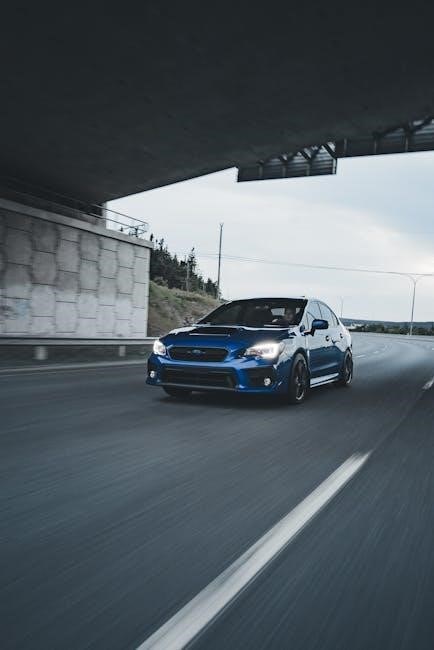
7.1. Mathematical Modeling of Race Car Dynamics
Mathematical modeling in race car dynamics involves creating detailed equations to simulate vehicle behavior under various conditions. These models incorporate factors like tire friction, aerodynamic forces, and suspension geometry to predict performance. By using tools such as the Moment Method and pair analysis, engineers can analyze how forces interact and optimize the car’s design for better stability and speed. This approach allows for precise simulations, reducing the need for physical prototypes and accelerating the development process. Accurate modeling also helps in predicting lap times and identifying areas for improvement, making it a cornerstone of modern race car engineering.
7.2. Lap Time Simulation and Analysis
Lap time simulation is a critical tool in race car engineering, enabling teams to predict and optimize performance on specific tracks. By integrating data from tire characteristics, aerodynamics, and vehicle dynamics, simulations provide insights into how design changes impact speed and handling. Engineers analyze cornering speeds, braking points, and acceleration zones to identify performance bottlenecks. This data-driven approach allows for virtual testing, reducing reliance on physical prototypes and accelerating development. Advanced software tools also enable real-time adjustments, ensuring that race cars are finely tuned for maximum efficiency and competitive advantage. Such simulations are integral to modern racing strategies.
7.3. Moment Method and Pair Analysis
The Moment Method and Pair Analysis are essential tools for understanding race car dynamics, as detailed in Milliken’s comprehensive work. These techniques allow engineers to analyze tire forces and vehicle stability by breaking down complex interactions into manageable components. The Moment Method focuses on the distribution of forces around the vehicle’s center of gravity, while Pair Analysis examines the balance between front and rear axles. Together, they provide insights into handling, traction, and overall performance. These methods are invaluable for optimizing race car setups and informing aerodynamic and suspension design decisions to enhance competitiveness on the track.

Vehicle Dynamics Testing and Development
Vehicle dynamics testing involves on-track data acquisition, simulation tools, and iterative design processes to optimize race car performance, ensuring stability, speed, and reliability under various conditions;
8.1. On-Track Testing and Data Acquisition
On-track testing is crucial for validating race car performance, involving sensors and data loggers to capture real-time metrics like speed, acceleration, and tire forces. This process ensures accurate insights into vehicle behavior under race conditions. Advanced tools, such as GPS and inertial measurement units, provide detailed data for analysis. Engineers use this information to optimize aerodynamics, suspension, and powertrain systems; Lap time simulations and tire data normalization are key techniques derived from on-track testing. The iterative process of testing, analyzing, and refining enhances overall vehicle dynamics, ensuring peak performance and reliability on the track.
8.2. Simulation Tools for Vehicle Dynamics
Simulation tools play a vital role in race car vehicle dynamics, offering precise models to predict performance under various conditions. These tools enable engineers to analyze tire behavior, aerodynamics, and suspension dynamics without physical prototypes. Lap time simulations and tire data normalization are key applications, optimizing vehicle setup for enhanced stability and control. Widely used in Formula SAE and professional racing, these simulations allow iterative design improvements, reducing development time and costs. By mimicking real-world scenarios, simulation tools help fine-tune race cars for maximum efficiency and speed, ensuring competitive performance on the track.
8.3. Iterative Design and Development Process
The iterative design and development process in race car vehicle dynamics involves continuous testing, data analysis, and refinement. Engineers use simulation tools and on-track data to identify performance gaps, then make targeted design adjustments. This cyclical process ensures optimal vehicle setup, balancing speed, stability, and control. Each iteration builds on previous insights, driving incremental improvements. Detailed in resources like Milliken’s Race Car Vehicle Dynamics, this methodical approach is crucial for achieving competitive performance, ensuring every component works harmoniously to maximize efficiency and speed on the track.
The Future of Race Car Vehicle Dynamics
The future involves integrating AI, machine learning, and sustainable technologies to enhance race car performance, efficiency, and environmental impact, as detailed in Race Car Vehicle Dynamics resources.
9.1. Emerging Technologies in Race Car Engineering
Emerging technologies in race car engineering are revolutionizing vehicle dynamics, with advancements in tire modeling, aerodynamic systems, and simulation tools. Innovations like active aerodynamics and advanced materials enhance performance and efficiency. The integration of hybrid powertrains and energy recovery systems is reshaping power delivery. Additionally, real-time data analysis and machine learning optimize race strategies. These technologies, detailed in Race Car Vehicle Dynamics resources, enable engineers to refine designs iteratively, ensuring faster, more stable, and sustainable race cars, while maintaining the thrill of competition and innovation in motorsport.
9.2. The Role of AI and Machine Learning
AI and machine learning are transforming race car vehicle dynamics by enabling real-time data analysis and predictive modeling. These technologies optimize tire wear prediction, fuel consumption, and lap time simulation. Machine learning algorithms process vast datasets to refine aerodynamic designs and suspension setups. AI-driven tools simulate race scenarios, offering insights into vehicle behavior under varying conditions. By leveraging these advancements, engineers can make data-driven decisions, enhancing performance and reliability. As detailed in Race Car Vehicle Dynamics resources, AI and ML are indispensable in modern race car engineering, driving innovation and competitive edge in motorsport.
9.3. Sustainability and Its Impact on Vehicle Dynamics
Sustainability is reshaping race car vehicle dynamics, with a focus on eco-friendly technologies. Hybrid and electric powertrains are being integrated to reduce emissions while maintaining performance. Lightweight materials and aerodynamic optimizations aim to enhance efficiency. Tire compounds are being developed to minimize wear and environmental impact. Recycling and energy recovery systems are also being explored. These advancements not only align with global sustainability goals but also drive innovation in motorsport, ensuring race cars remain competitive while embracing greener practices. The fusion of sustainability and performance is a critical evolution in vehicle dynamics, as highlighted in modern racing engineering resources.
